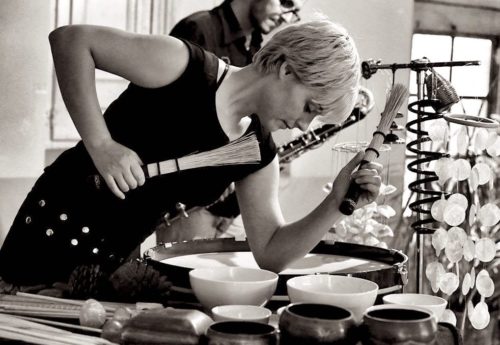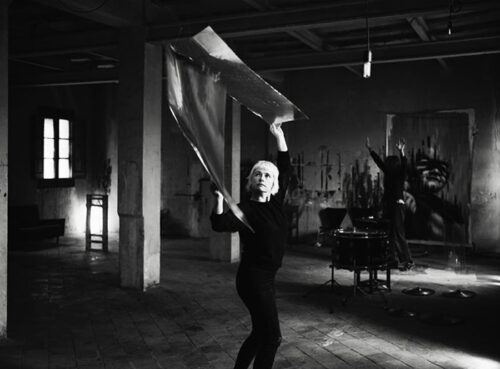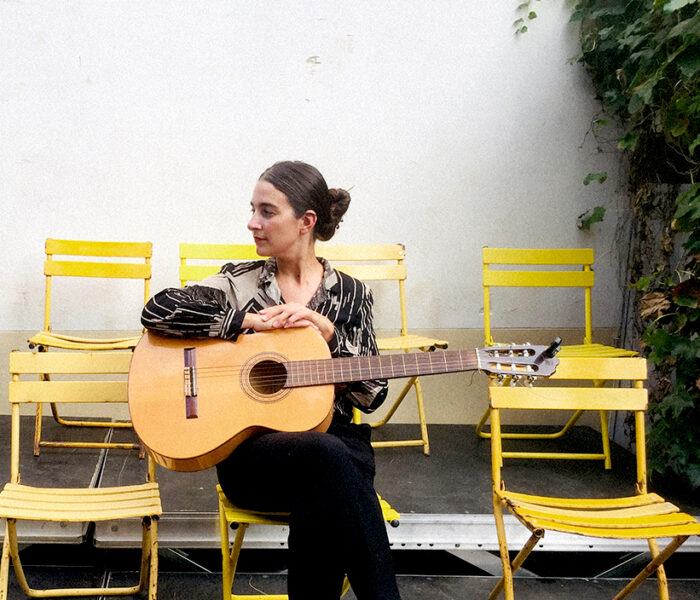Percussionniste contemporaine et improvisatrice exceptionnelle, Nuria Andorrà persiste dans la recherche de son propre langage depuis que, enfant, elle a découvert avec étonnement l’univers sonore vital et énergique que la percussion ouvrait dans son corps. “Je sens la vibration dans mon estomac”, dit-elle à un moment de l’interview. Directrice artistique du festival MontMusic et professeur de percussion au conservatoire de Reus, Nuria Andorrà manifeste un intérêt pour l’interdisciplinaire, où le corps, l’image et le son s’unissent pour offrir une émotion singulière et intransmissible. Récemment récompensée par le prix Alicia de l’Académie catalane de musique 2021, elle est considérée comme l’une des meilleures improvisatrices d’Europe aujourd’hui. Nuria Andorrà a également collaboré avec des artistes tels que Carles Santos, Hector Parra, Fred Frith et Joëlle Léandre, entre autres.
Enfant, vous n’étiez pas émerveillée par le piano, mais par les percussions.
J’étais un enfant agitée et lorsque j’ai découvert les percussions, tout un univers s’est ouvert à moi.
Avec le temps, avez-vous compris cette première émotion devant l’univers de la percussion ?
Je pense que j’ai été touché par l’essence la plus originelle. J’ai senti la vibration dans mon estomac. Ça m’a comblée. Avant l’arrivée des autres instruments, j’imagine qu’au début il y avait la percussion, que les êtres humains ont commencé à battre et à chanter, avant toute autre chose, n’est-ce pas ?
Oui, il y a quelque chose d’atavique et de tellurique dans la percussion. Si l’on pense au présent, diriez-vous qu’il y a un boom dans le monde de la percussion mené par des femmes ?
Peut-être, c’est possible, bien que je pense que nous reculons, qu’il y a une régression. Je regarde les classes d’étudiants en musique et je pense qu’aujourd’hui il devrait y avoir une parité, mais je ne la vois pas.
Vous ne pensez donc pas que l’on puisse parler d’un mouvement actuel ?
C’est peut-être un mouvement de balancier. Il n’y a pas d’étude ou d’analyse, mais j’ai le sentiment, oui, qu’il n’y a pas assez de modèles.
Vous êtes artiste, percussionniste, enseignante, chercheuse et même directrice de festival. Comment toutes ces facettes s’entremêlent-elles ? Qu’est-ce qui les unit ?
Certaines facettes sont militantes et toutes s’entremêlent. Par exemple, je conçois la pédagogie comme une transmission égalitaire des connaissances. Je ne crois pas au rôle autoritaire de l’enseignant. En fait, pour moi, c’est un point d’ancrage vital et c’est pourquoi j’enseigne dans une académie. La recherche est un dialogue d’enrichissement avec d’autres artistes, car dans le milieu contemporain, il y a beaucoup de place pour la recherche. Une artiste comme moi a pour objectif de monter sur scène et de s’entourer d’autres musiciens aussi ou plus compétents que moi, en recherchant l’interrelation et l’interdisciplinarité pour créer la même émotion, le même sentiment.
Vous enseignez l’improvisation contemporaine. Mais comment l’enseigner ?
Il existe déjà un langage basé sur les structures ou sur la résistance du matériau, avec sa philosophie sur le moment où il faut intervenir et celui où il ne faut pas le faire, etc. En outre, il existe une série d’éléments qui entrent en jeu lors de l’improvisation, comme l’écoute, par exemple. En fait, l’écoute est rarement enseignée, et pourtant on a tendance à sur-enseigner la partition. On ne propose pas à l’élève les ressources qui lui permettraient de s’autoréguler et d’être son propre guide. En improvisation, il est important d’approfondir l’écoute, l’interaction avec les autres et de savoir comment réagir en temps réel sur scène.
Comme une conversation ?
C’est en effet une conversation, dans laquelle se développe un processus créatif, un ébranlement qui se propage. Nous commençons à parler du printemps et finissons par réfléchir sur le corps. De plus, étant en temps réel sur scène, elle exige du public qu’il participe et soit attentif à ce qui se passe, qu’il écoute et découvre où la mélodie du violon va se déplacer, à quel moment elle va fusionner avec les percussions, etc. Un dialogue plein de nuances dans lequel, par exemple, la percussion n’accompagne pas seulement, mais crée aussi la mélodie.
Diriez-vous qu’il y a un manque de culture d’écoute de la musique contemporaine ?
Oui, il y a un manque d’écoute, et nous sommes à des années-lumière de pouvoir l’obtenir, surtout si l’on regarde nos programmes musicaux par rapport à ceux d’autres pays. Nous avons besoin de beaucoup de pédagogie. La musique contemporaine invite à faire un effort et vous serez récompensé, mais les institutions ne la soutiennent pas, or c’est ce genre de musique a besoin de ce soutien.
Comment évaluez-vous la scène actuelle en Espagne, en Catalogne et à Barcelone ?
Je dirais simplement qu’en France et en Allemagne, ils sont à un niveau différent.
Et des festivals comme Mixtur ou LEM ?
C’est très intéressant, mais il y a un manque de soutien économique et institutionnel. Je dirige un festival d’improvisation MontMusic et je remarque que mes collègues européens bénéficient d’un meilleur soutien. Ici, on repart de zéro et on ajoute un peu de militantisme. LEM et NOA font un excellent travail, mais ils se plaignent des mêmes faiblesses. Le LEM a été un succès. Petit à petit, je pense que nous atteindrons un niveau supérieur.
Sur quoi travaillez-vous en ce moment ?
Miratges, une pièce interdisciplinaire, avec une structure sonore sur scène, basée sur l’interaction et l’improvisation. Nous sommes très enthousiastes et attendons de voir ce qui va se passer. Je travaille également sur NU.A, une œuvre vidéo dans laquelle je traite en temps réel les sons de percussion des pierres et des céramiques et surtout les cloches de vache de mon grand-père, qui était berger. Je retrouve les sons originaux de mon enfance. En fait, les cloches dégagent encore l’odeur de l’agneau! Entre ces projets, je poursuis mes concerts d’improvisation. En juin, je présenterai pour la première fois en public à Barcelone au Mercat del Flors, Constelaciones, la pièce pour laquelle j’ai reçu le prix Alicia.
Comment définiriez-vous votre style, votre univers créatif ?
Je ne sais pas, c’est une question à laquelle il est très difficile de répondre. Je préfère que vous écoutiez et que vous mettiez les étiquettes. Mais, peut-être que ma musique recherche les extrêmes, à la fois dynamique et énergique, de la puissance et de a fragilité du son, j’aime interagir et communiquer en temps réel sur scène, avec des structures fixes, mais aussi ouvertes.
Quels critères utilisez-vous pour choisir un certain instrument ou un certain son ?
J’essaie de m’écouter et de découvrir ce que je dois faire pour évoluer en tant qu’artiste, ce que je dois étudier pour m’améliorer. Dans Constelaciones, j’ai travaillé avec les émotions de chaque scène et le rythme-énergie que je voulais trouver dans l’ensemble de la pièce. Une fois que je les ai obtenus, je me suis concentrée sur le timing de la scène, me demandant quel crescendo elle demande, quelle fragilité la pièce exige, tout en trouvant assez de force pour aller de l’avant, en faisant interagir le délicat avec l’énergique. Pour NU.A, comme c’était pendant le confinement, j’ai eu le besoin de revenir vers mes origines, de savoir pourquoi je me suis consacrée à la percussion. Alors j’ai cherché les sons qui résonnaient en moi quand j’étais enfant, qui m’enveloppaient. Je pense à la nuit, aux premiers rêves de mon enfance, aux céramiques de la maison qui produisaient des sons, aux pierres qui viennent de la terre. De tout cela, j’ai pu extraire de la matière, comprendre ce qu’elle m’offre.
Recherchez-vous la diversité ?
Oui, parce que je ne me cantonne pas à un seul son. La percussion englobe un univers présent dans toutes les cultures. Par exemple, je voyage pour découvrir les percussions en Inde ou en Turquie.
Que pensez-vous de la voix en tant qu’instrument ? Elle a sa résonance?
J’aime beaucoup, oui. C’est un instrument qui m’attire et qui m’inspire beaucoup de respect.
Comment avez-vous vécu la pandémie ?
C’était contradictoire. D’une part, j’ai eu plus de temps pour créer Constelaciones. La pandémie m’a obligé à m’arrêter, ce qui est très important. Mais avec la pandémie, vous devez vous adapter à des circonstances très incertaines que nous vivons tous ou dont nous souffrons. Dans le monde de la musique par exemple, j’entends par là le fait qu’un musicien soit testé positif ou non, je pense à l’annulation de concerts à la dernière minute, etc. D’une certaine manière, la pandémie freine la croissance, même si j’ai le sentiment qu’elle est en expansion.
Txema Seglers



)






